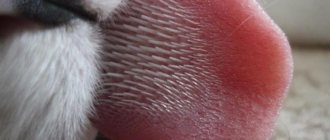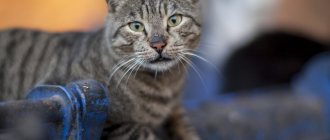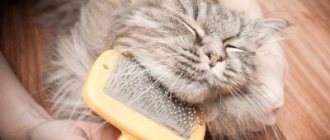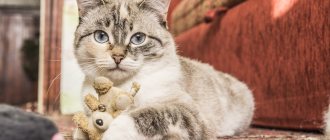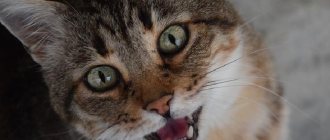Do you think cats meow, purr, purr and howl simply because they feel like it? But no. In fact, they convey to us their perception of the world and share their feelings. Cat language is not that difficult to understand: the main thing is to listen carefully.
Cats have the widest vocal range. As Joy-pup.com , the range of sounds they make is much wider than the well-known meowing, purring, hissing and grumbling.
Cats have an opinion about everything in the world, and they express it very clearly, and with different intonations. Using them, you can determine the pet’s emotional state: pleasure, peace, anxiety, fear and even anger.
Meow
“Meow” is the most common sound that adult cats use exclusively when communicating with humans. Wild kittens meow, calling for their mother, but as they grow older, the “baby” vocalization gradually disappears. But domestic cats remain eternal cubs, and therefore, just in case, they retain this ability for their entire lives. Why does the cat meow? As a rule, because he wants something: to eat, to chat, or just to get in/out. Some cats use “meow” to greet: “He’s finally arrived!” Welcome home!
Sometimes “meow” speaks of loneliness or even illness. Older cats may meow more often because they are getting weaker and worry that they are not as agile as they used to be. In young cats, “meow” is often shortened to the interrogative “me?”: this is how they report that they are bored or hungry. The frequency of meowing is an indicator of a cat's mood. Quick, impatient “meows” mean “Pay attention to me, I’m talking to you!”
A drawn-out, plaintive “m-a-a-a-u” usually indicates that the cat is agitated, irritated, or indignant. She seems to say: “That’s it, stop it!” Continuous loud meowing may indicate pain or injury: in this case, you need to rush to the vet.
Alternative view
What does the cat want to say with its persistent meowing? Why does she purr like that? Are the sounds made by cats from different countries different? To find out all this, Swedish scientists launched a special linguistic project. And it has already given the first results that will be of interest to all cat owners. For example, it was discovered that cats have sounds intended only for humans.
What does the cat want to say with its persistent meowing? Why does she purr like that? Are the sounds made by cats from different countries different? To find out all this, scientists launched a special linguistic project.
—
The idea to study the sounds that cats make was born during a talk on the difference between the purr of a large cheetah and a small domestic cat.
“Is it really possible to use the same methods used to study human speech to study the sounds made by animals? How interesting!" - I thought.
Susanne Schötz, an expert and teacher of phonetics, was in the audience, and the talk was read by Robert Eklund, Professor at the Department of Languages and Cultures at Linköping University. And so they launched a project together to study cat sounds.
During the five-year project, scientists used phonetic methods developed for humans to study how cats communicate with people using their various sounds.
According to Susanne Schötz, kittens meow when they want to attract the attention of their mother, but most often with age they stop doing this, unless they get to a person - then they continue to use meowing when they want to get the attention of their owner or comrade.
“I think that every cat and the family in which it lives develops something in common over time, almost a unique language with many nuances, and both parties learn to understand it.
I think cats can learn new nuances of language,” says Susanne Schötz. Promotional video:
She claims cats try different approaches. If one type of meow doesn't work, they create another. When a cat finds a particular meow that works if she asks for food or to clean the litter box, for example, she continues to use it.
To learn more about how cat-human communication occurs, scientists have so far recorded the sounds of about 70 cats. They are now sorting through the recordings and dividing them into different categories: meows, purrs, purrs, coos, growls and howls.
Scientists then use scientific phonetic techniques to better understand these sounds. In the video, they watch how cats articulate, how they open and close their mouths when they make sounds. Scientists identify the distinctive acoustic signatures of these sounds using computer programs that analyze human speech. The program was modified so that it could also be used to analyze cat sounds.
“We focus on melody and intonation. "We found a lot of variation here that we think may be related to the cat's mood and probably to the situations in which the cat uses these sounds to communicate with people."
“We've done a lot of preliminary research that shows, for example, that a cat's meowing is different in stressful and frightening situations, when he's, say, riding in a carrier to the vet, than the sounds he makes at home in the kitchen waiting for breakfast.”
Even before starting this research project, Susanne Schötz began doing cat research in her spare time. She herself has five cats.
As a phonetician, she has participated in many research projects on Swedish dialects: how they are articulated, how their melody varies, and how vowels are used.
“If you have cats, like I do, and at work you spend all day listening to the subtle nuances of human speech, it’s easy to start listening to cat sounds in the same way.”
She listened to the cats make sweet, cooing noises when they were sitting in the window watching the birds, as well as more aggressive sounds when they were defending themselves from something.
“When in the spring we sometimes had battles for territory with the cats living next door, I went out with a video camera and recorded their grumbling and howling,” she says.
Susanne Schötz gave several popular science talks about her little cat project and saw that many people were very interested in it. After some time, the scientists received funding and were able to officially begin the research, which they did in parallel with other work.
A recording of cat sounds was given to 30 participants - both cat owners and others - and surprisingly often people were able to determine where the cat was, in their kitchen or at the veterinarian.
“Even those who do not have their own cat gave the correct answer too often for it to be called mere chance.”
The next step will be to measure the frequencies of the fundamental tone of the cat’s “speech” and associate them with various situations and moods of the animal. This way, scientists will understand how melody varies.
“If this is indeed the case as our preliminary studies suggest, then we have taken a step forward toward better understanding our cats.”
Dagens Nyheter: What do you hope to achieve with this research?
Susanne Schötz: When we're done, anyone can go to our project page and listen to cat sounds. Thus, perhaps, it will be a little easier for someone to understand what their cat wants to tell him with some of his special meows.
She also says the research could be useful in the elderly care industry, where cats have become a big focus in recent years. And veterinary clinics may be better able to determine whether a cat's meowing means that something is hurting the cat.
Now scientists are trying to solve one small problem: the sounds made by different cats can be very different from each other. Just like people, cats have different voices. A cat’s voice depends on the age, gender and size of the animal, and they, just like us, have different personalities.
“We can’t ask our animals what they want to say with their different sounds, so we have to resort to other scientific methods and make educated guesses,” explains Susanne Schötz.
Scientists have noticed that the timbre of an animal’s voice and partly its melody is greatly influenced by its character, however, there are also general trends that are true for most cats.
“Most meow and can coo and purr in a friendly manner,” says Susanne and demonstrates these different sounds to us.
How often cats meow depends very much on the individual animal, says Susanne.
“Some cats are more extroverted, outgoing and social, they want to be with a person. Others are more reserved, perhaps shy and fearful. But we also noticed that it largely depends on how much owners talk to their cats.”
In parallel with recording the sounds made by cats, scientists asked their owners how often they communicate with their pets and how actively cats communicate using sounds.
“We concluded that the more you talk to the cat, the more the cat will talk to you.”
Susanne Schötz emphasizes that, in general, scientists have studied more not cats, but dogs, not to mention birds, in the context of sound communication.
“We hope to gather more knowledge about cats. Since we are linguists and not biologists, our research comes from a different angle. After all, we use the same methods as to study human language. We look at articulation—how cats move their mouths when they meow, howl, or hiss.”
She emphasizes that scientists, of course, clearly understand that cats do not have speech in the same sense as humans.
“But they have a tongue, vocal cords and lips - just like us. They have a jaw that they can raise and lower. They form their sounds in much the same way that we form speech.”
- What exactly are these individual cooing sounds?
“We found that this is a very high-frequency sound, they make it almost more often than purring itself - but cats can purr even when they are hungry or stressed. Often individual murmurings work as a greeting, but only between friends. Also, these sounds can express gratitude if the cat received something good from its owner or friend.
— What is the difference between a single purr and a long purr?
— There is a big difference both purely linguistically and phonetically. Purring is unique in that cats can purr both while inhaling and exhaling, and therefore the purring can continue for a very long time. A separate purr is a short “mrrrk”, after which the air runs out.
In addition, the sound volume of a continuous purr is much lower than that of an individual “purr”: between 20 and 30 Hz and lower. This is somewhere on the border of perception of the human ear.
The classic purr, according to Susanne Schötz, occurs when the cat lies quietly and rests, satisfied with itself and the world around it.
“A hungry cat can mix individual purrs and even meows into its purring, and then it becomes louder,” she says and imitates the sounds. “Then the purring has a completely different intensity.”
“This ability to nuance sounds and mix sounds with others is very common, and sometimes for us it is associated with some difficulties, we find it difficult to separate sounds into categories,”
Such a wide variety of sounds also indicates that cats express their intentions, desires, needs, and moods in a rather complex way, says Susanne Schötz.
Next, as part of the project, scientists are going to find out whether human dialects influence the sounds made by cats. To do this, they record cat sounds in different parts of Sweden: Stockholm, Östergötland and Skåne.
Research project
“Melody in communication between humans and cats” is a five-year research project that scientists are working on part-time at Lund University.
The project involves Susanne Schötz, Associate Professor at the Department of Phonetics at Lund University, Robert Eklund, Professor at the Department of Languages and Culture at Linköping University, and Joost van de Weijer, Associate Professor at the Department of General Linguistics at Lund University.
The project is funded by the Marcus and Amalie Wallenberg Foundation.
Various sounds made by domestic cats
Purring is a weak, continuous sound at very low frequencies. Cats purr not only when they are happy, but also when they are hungry or stressed.
A separate purr is often a rather short, nasal, soft and weak sound. Primarily used in a friendly atmosphere.
Meowing is mostly reserved for us humans. It is used in many different situations and is divided into different subcategories that can be mixed together (for example, meow with elements of purring, howling meow, whining meow, meow with grunt).
A howl is a long, sonorous warning sound with either a descending or rising intonation, which is usually repeated, gradually increasing in intensity.
A grunt is usually a very low, muffled and prolonged sound involving the vocal cords. Usually denotes danger or is used to scare off an enemy.
Hissing and spitting are warning and deterrent sounds produced by a tense, open mouth with a raised upper lip and bared teeth.
Shouts and screams are short, high-pitched and loud sounds, often hoarse or hoarse, consisting only of vowels. Used in physical combat or as a final warning.
Cooing and clicking sounds occur when cats see prey. Short sounds without using the vocal cords. The cooing sound resembles the chirping of birds or the squeaking of rodents - perhaps this is an imitation of the sounds of prey.
Hans Arbman
Purr
Soft and deep throat vibrations are an extremely pleasant, hypnotic sound that shows that the cat is in the best mood. If you lightly stroke it, the pleasure intensifies and the “motor” gets louder. Plus, a cat's purring is good for your health!
It happens that cats purr when they are worried about something. Something like how we nervously whistle or hum while waiting for our spouse's parents to come to dinner. This type of purring is easy to recognize by its posture: if the cat's ears are turned back and his body is tense, it means he is excited.
What are the ways cats communicate?
Various sounds
According to scientists, cats are capable of giving about 100 intonations to their voices and have a wide range of sounds - from a low purr to a high-pitched squeal. Researchers have proven that cats, when communicating with humans, can pronounce the letters “r”, “i”, “u”, “m”, “x”, “a”, “f”. Therefore, the pet can say a lot depending on the situation:
- Fear, anger. Expressed in a low guttural growl or a sharp piercing scream, hissing.
- Satisfaction. Characterized by affectionate cooing or a short “meow.”
- Pain. During illness, the cat emits a plaintive moan.
- Joy. The cat screams jubilantly at the top of her vocal cords.
- Requirement. The pet does not leave the owner, looks into his eyes and, depending on his character, meows demandingly and persistently loudly or purrs quietly, poking him with his muzzle.
- Communication with kittens. The mother cat speaks to her babies in a special way, producing a mixture of coos and gentle meows.
Multifaceted facial expressions
In response to an unpleasant smell, the animal usually curls its face.
When cats talk to people, the animals reinforce their feelings and emotions with movements of the muscles of their faces. Sometimes the expression of the muzzle is not associated with the manifestation of a state of mind, but nature endowed the animal with such a “face,” for example, like the famous “angry cat” Tardar Sauce. However, all pets show emotions in this way:
- “I’ll attack now.” The cat crouches to the floor, head raised, upper lip and pinches slightly raised, but not exposing teeth.
- "Hello". The pet's facial muscles are relaxed, and his lips seem to stretch into a smile. Due to the not fully formed “face” of kittens, their lips are constantly smiling.
- "Ugh". If you bring an object with a pungent odor to a cat’s nose, the pet wrinkles its nose, grimaces, and closes its eyelids.
- "Smells nice." The pinches tense, their mustaches push forward. The muscles of the nose are actively working at this time, inhaling the smell. The cat freezes with a concentrated expression on its face, its mouth is slightly open. So the animal tastes the aroma through the Jacobson organ.
Expressive eyes
If an animal watches something with interest, then it is extremely difficult for him to tear himself away from this activity.
Many people claim that cats have a piercing and magical look. Even if the pet does not move, you can talk to the cat through the eyes in this way:
- Interest. The gaze looks at the object of interest and at this time it is impossible to distract the cat.
- Requires attention. The pet sits next to the owner and continuously looks at him.
- Subordination. The cat looks away a little, avoiding looking at the owner. However, sometimes looking away to the side can indicate that the interlocutor is tired of him and the animal wants to get rid of him.
- Indifference. The cat seems to be looking “into nowhere”, the gaze does not express anything, the eyelids are half-lowered.
- Hunting. When you see a moving object, the pupils dilate and an illusion is created, as if the organs of vision are popping out of their sockets.
- Disease. The expression in the eyes is full of torment and melancholy.
Body language
According to the observation of K. Bessant, the ears are an important organ of communication, since they have about 30 muscles and rotate 180 degrees, can move one independently of the other, rotate, rise and press against the head.
If a pet is happy to meet its owner, then it greets him with its tail raised up.
When communicating with the owner, the kitten, or each other, the cat expresses most of its feelings through a complex of gestures and body movements. Therefore, you can learn to correctly understand pets and find out what they respond by observing them in different situations. A pet can speak with gestures in its own language like this:
- Aggression. The ears are pressed tightly to the head, the whiskers are erect, the tail lashes furiously at the sides of the body. The cat makes the sound of a dull growl or screams angrily.
- Anxiety. The ears turn to the sides, slightly laid back. The animal jumps to its feet, the whiskers are erect, the tail trembles slightly.
- Interest. The cat continuously looks at the object, the body is tense, the tip of the tail moves to the sides.
- Irritation. The pet sits or lies, the muzzle expresses dissatisfaction, the tail turns slightly to the sides.
- Joy, greeting. The pet purrs or meows loudly, turns its butt and raises it, the tail is straight and raised high. There is complete satisfaction on the face. Some cats jump on their owners and lick their faces.
- Demand for attention. The cat persistently climbs up to the owner, catches his eye, purrs, pokes his muzzle into his hands, and rubs himself.
- Satisfaction. The animal is relaxed, purrs contentedly, “kneads” the owner or simply dozes.
- A game. Small kittens play with each other and often arch their backs and tails into an inverted "U" shape. However, in children this position does not mean aggression. This is how a kitten and an adult cat splashes out excess energy during crazy running and jumping around the room.
Chirping, Chirping and Trilling
Translating bird sketches from cat to human is much easier than the multifaceted “meow”. They are learned in childhood: in this way the mother attracts the attention of the kittens and calls them to follow her.
An adult cat can also “chirp”, trying to capture our attention or show something important. Chirping and short creaking trills mean that the cat is delighted.
Login to the site
How to talk to a cat? It is well known that if a cat purrs, it means she is very pleased; if she twitches her tail, she is dissatisfied with something. But in the cat’s arsenal there are many other ways to convey your point of view to the “interlocutor”.
The cat, as you know, walks on its own, even in your house. She also sleeps on her own, purrs, jumps on cabinets, digs in flowers, sometimes tears up furniture and does many other things without your permission or participation. But how nice it is when this self-made animal in the evening, after righteous labors (both yours and hers - in your absence), pays close attention to you. And here it is important not to lose face - and to understand what this creature wants from you. It is well known that if a cat purrs, it means she is very pleased; if she waves or twitches her tail, she is dissatisfied with something, hisses - don’t come closer, I’ll scratch you. But in the cat’s arsenal there are many other ways to convey your point of view to the “interlocutor”. All that remains is to understand the intricacies of this “language”.
Eyes. Just like yours, a cat’s eyes are the mirror of the soul. If she looks intently in one direction without looking away, it means she is very interested in something. And now it’s better not to bother her. Widely dilated pupils, a “evil” look - the cat is very scared. A slight squint of a cat lying to the side indicates that now she is clearly not in the mood to talk with you.
Ears. Another important indicator of a cat's mood. Pressed to the head, they indicate that the cat is aggressive and ready to attack. He moves his ears, which means he listens, “calculates.” If you were petting a cat, petting it, and then stopped, it, slightly pressing its ears, will show you displeasure, saying, don’t be stingy with affection.
Tail. The main “barometer” of cat weather. Stretched out like a pipe, it means the cat is friendly. Usually, a cat greets its owners with this “flag” when they return from work. The tail may even quiver slightly (with joy). Raised at an angle of 45 degrees - betrays indecision. The usual position when meeting guests. The cat doesn't yet know how to treat strangers. The tip of the tail is shaking - it means the cat is in a playful mood. Hurry up and take out the candy wrapper on a string before she starts playing with your notebook. Hit the floor - the cat is determined. She is very dissatisfied with something and warns that her patience is about to burst. This movement of the tail is also observed in a predator during a hunt, when the animal is preparing to jump on its prey. Lowered or even squeezed between the paws - the cat is very scared. Extended parallel to the floor - evidence of cat favor. Lowered down and extended at an angle of 45 degrees - the cat is alert, one awkward movement - and she will either flee or begin to defend herself. Raised up and fluffed up, it means that the owner of the tail is scared, but is not trying to retreat, but, on the contrary, wants to intimidate the enemy.
Voice. Meows briefly and says hello. Meows repeatedly - she’s bored, or hungry, or went to the toilet. In any case, this is how she wants to attract your attention - just answer the call - the cat will find a way to explain to you what exactly she needs. My cat, for example, meows long and monotonously every morning until I get out of bed - he works as an alarm clock on a voluntary basis. As soon as you go into the kitchen, he immediately climbs onto the windowsill, curls up and falls asleep. If a cat makes a sound of a medium tone, it means it is making excuses, atone for its sins - it makes sense to look under the bath... The tone of the sound is high - it is angry or in pain. The sound is low - it demands something, the meowing is prolonged - it is complaining.
Be sure to talk to your pet, just don’t shout. Nothing will change anyway, but you will ruin both your and your cat’s nerves. And of course, don’t go as far as assault – the weight categories are not the same, and this cunning creature will definitely find a way to take revenge (you’re not at home all day).
By the way, cats can easily recognize your mood by their intonation and decide whether to pester you now or wait for a more favorable moment. And if you persistently repeat a word, associating it with an object, the cat will remember the consonance and will react appropriately. She responds to her nickname, why not continue her studies - after all, you can master words that caress the cat’s ear like “meat” or “milk”. Study the cat's language, be sensitive and attentive to it. Believe me, she has already studied you for a long time. (c) All about cats Source → Over a cup of tea
Hiss
With hissing everything is clear. If a cat hisses like meat on a hot frying pan, there is no doubt that it is scared and ready to attack. The big, but stupid dog is in vain trying to make friends with her: a furious protest awaits him (it is possible that with the use of knives). The threatening sound is complemented by eloquent body language: the back is arched, the fur is on end, the tail is a pipe, the ears are pressed back, the mouth is open, the fangs are in combat readiness. In addition, cats can not only hiss, but also spray saliva (non-poisonous). In general, when a cat turns into a dragon, it's best to retreat.
At the same time, hissing is very dependent on the character and living conditions of a particular cat. Friendly, sociable cats hiss extremely rarely, while more reserved and cautious cats go on the defensive just in case. Stray or feral cats, who are not spoiled by life, turn on the hissing mode much more often than well-groomed, socialized pets.
Is it true that cats can talk?
Graceful pets like cats cannot communicate with their owners using words. But that doesn't stop them. Each owner knows his pet so much that he basically always understands what his pet is purring about. More recently, scientists have begun to conduct research on cat sounds. Their opinions are quite different, but it can still help when communicating with representatives of the feline family.
Cats can talk
Cats communicate through more than just sounds. In this process, their overall body position, facial expressions, eyes, and tail movement play a big role. Taken together, all this will help you understand their sounds much better. And if you pay attention to the cat’s behavior at the same time, its language will become even clearer. A smart pet will sit next to its bowl and meow when hungry. Another example would be a cat's desire to play. At the same time, she will not only meow, but will also bring her favorite mouse.
Cat tongue
It is almost impossible to decipher a cat's language. If you listen to their sounds in a recording without seeing the pet’s behavior, they will seem completely identical. A cat's tongue is directly related to their postures and movements in a particular case. Every cat behaves differently. Accordingly, it is impossible to determine exactly what a particular sound means. Cats most accurately understand human language, namely the intonation with which words are pronounced. In some cases, when communicating with its owner, a cat may use sounds that it does not produce when communicating with animals or with other people. This means that they are selective and want to convey some information to a specific person.
Most people who have a cat can recognize their pet by its sounds. This happens because each cat has its own intonation of pronounced sounds. It also differs between different breeds. Living next to another animal, a cat can sometimes try to imitate their sounds, for example, try to whine, click, or quack. There are cases in history when owners found their lost pets due to the fact that the cats uttered sounds with an intonation that the owners knew well.
The human ear can distinguish 16 sounds that a cat makes. They can also reproduce ultrasonic signals. Cats are designed to sense a wide range of frequencies. That is why their hearing is much better than that of humans.
So it’s impossible to say for sure whether cats can talk. But definitely, they communicate not only with the animal world, but also with people.
Grunts and growls
Growling and growling often alternate with hissing and also mean fear, anger or a desire to protect one’s territory. Unlike large cats - lions and tigers, domestic cats growl and grumble in high tones, beginning or ending with a howl. In general, unless a cat is threatened by another cat, just leave it alone. Remember the classic defensive position?
How to communicate with a cat? Myths and misconceptions
1. The cat doesn’t listen because he wants to be the boss in the house, to dominate. This is not true. Dogs that once hunted in a pack can dominate, so they needed a distribution of roles. Cats have always been solitary hunters, always lived on their own, so they simply do not know words like “submission.”
2. The cat should like being stroked. This is not always the case; it also depends on the cat’s personal experience. If he was once picked up and thrown roughly onto the floor, he will not want to go to a person, he will bite and fight. Also, the cat does not like it if a person hovers over his head, raises his hand, and when stroking him, presses too hard. If you want to pick up a cat, do not make sudden movements, everything should be smooth and soft. He likes it when his owner scratches behind the ears or just below the cheeks.
Photo: Depositphotos
3. Any manifestation of a person’s feelings for a cat is a plus in communication. Sometimes we like to get close to the cat's face and look straight into his eyes. Such behavior in nature is regarded as aggressive, so you should not be surprised that the cat ran away or scratched and bit.
4. The cat rushes at the legs and arms of the owner, as his instincts speak. This is actually play behavior in cats. Once upon a time, the owners themselves tried to strengthen him by playing with the cat, which is why he grew up confident that legs and arms are also toys. As soon as the kitten decides to play with an arm or leg, you need to freeze and snort sharply. He must stop, because this is how his mother cat once raised him. At this moment, you need to remove your hand and slip your pet a toy or at least a sock so that he switches to a new object.
5. The cat must understand that it is forbidden to climb on the table. Cats will always jump or climb higher, this is their natural instinct. If you scold him for this, he will direct his negativity at you, and not at the table or bedside table. To prevent your cat from climbing onto the table, offer him an alternative, that is, other surfaces located above the table - for example, allow him to sit on the refrigerator. How to stop climbing on the table? You can treat it with aromatic oils with a citrus scent.
Photo: Depositphotos
6. Cats take revenge by relieving themselves in the wrong place. Experts say that cats cannot be offended, much less take revenge. Sometimes the cause of their uncleanliness can be diseases of the genitourinary system. Or another option - for some reason the cat is not comfortable going to the toilet. Maybe you changed the filler or put the tray in a visible place. If you spanked a kitten because he made a puddle or a pile, he will assume that you did that because you saw it. And next time he will do everything to hide this “wealth” - for example, write on upholstered furniture, where everything will quickly be absorbed. The higher the cat's stress level, the higher the place he looks for the toilet. To avoid such incidents, it is necessary to provide the animal with access to the toilet, or better yet, place two trays.
Photo: Depositphotos
As we can see, any problems in communicating with a cat can be solved; the main thing is to understand why the pet behaves this way and not otherwise, and try to react correctly so as not to injure either yourself or the furry friend living nearby.
What else to read on the topic?
Why does a cat bite? Causes of Aggression in Cats Does your cat use a litter box? Is it true that a cat has nine lives?
Tags: cat behavior, misconceptions
Howl
This sound is very different from a demanding or puzzled meow and is more like a yearning, drawn-out moan that indicates anxiety, discomfort, territorial issues or mating needs. Howling is a way of communicating with other cats and can mean “I want to mate” or “Get off my property!” In addition, this happens when the animal becomes physically ill, loses sensitivity, cognitive functions are impaired, or the usual environment changes: for example, another cat appears in the house. Quite often, cats that have been moved to a new place or adopted into a new home howl because they are suffering from lost “hiding places.”
If your cat begins to howl continuously, take the animal to the vet immediately. If it has not yet been sterilized, it is important to resolve the problem as soon as possible. If the house is private, rivals will probably enter your cat’s territory: perhaps stray cats will be caught, neutered and placed in good hands. Make sure your pet has enough toys and attention. To stop the howling, sometimes it’s enough to play with the cat a little longer in the evenings.
Cat language
To understand how to teach a cat to talk, you need to study the language of furry pets. After all, they are capable of more than just meowing. Zoologists identify about 16 different cat sounds. Just a few of them can be cited:
- Purring. This sound is an expression of pleasure. The cat also purrs when greeting its owner or communicating with its cubs.
- Screams. Animals make such sounds when they are in heat and ready to mate.
- Snorting, rumbling, hissing. These sounds are a manifestation of aggression.
How to teach a cat to speak like a human? When teaching speech, it is necessary to rely on the sounds that your pet most often makes. Through long training, you can transform meowing and purring into sounds that resemble words. So, for example, “meow” can be converted into “meat”, and “mur” - into “eat”. It is necessary to identify sounds in your pet’s speech that are similar to human words and work on their pronunciation.
Sometimes you can hear cats making sounds on their own that are very similar to human speech. The owner should be alarmed if this happens involuntarily and is not the result of training. This usually indicates fear or extreme dissatisfaction of the animal. An example of such sounds can be heard in the video below.
Screams
Cats are not averse to responding to inviting cries, and if an unsterilized cat ends up on the street, a “wedding” is inevitable. She will lower her head, raise her pelvis (the position is called “lordosis”), the cat will grab her by the scruff of the neck and begin the mating act. For reference: the cat's penis is covered with thorns and causes unbearable pain to the cat, so she screams as if she were being cut. Moral: Spay your cats.
In the midst of a fight, cats also scream. Usually this primal cry is heard after a long, ominous howl and is followed by a decisive paw strike or a furious bite. Uncastrated cats are more aggressive, although castrated cats also actively defend their territory. If you want to protect your beloved cat from battle wounds, do not let him outside.
LiveInternetLiveInternet
It is well known that if a cat purrs, it means she is very pleased; if she twitches her tail, she is dissatisfied with something. But in the cat’s arsenal there are many other ways to convey your point of view to the “interlocutor”.
The cat, as you know, walks on its own, even in your house. She also sleeps on her own, purrs, jumps on cabinets, digs in flowers, sometimes tears up furniture and does many other things without your permission or participation. But how nice it is when this self-made animal in the evening, after righteous labors (both yours and hers - in your absence), pays close attention to you. And here it is important not to lose face - and to understand what this creature wants from you.
It is well known that if a cat purrs, it means she is very pleased; if she waves or twitches her tail, she is dissatisfied with something, hisses - don’t come closer, I’ll scratch you. But in the cat’s arsenal there are many other ways to convey your point of view to the “interlocutor”. All that remains is to understand the intricacies of this “language”.
Eyes. Just like yours, a cat’s eyes are the mirror of the soul. If she looks intently in one direction without looking away, it means she is very interested in something. And now it’s better not to bother her. Widely dilated pupils, a “evil” look - the cat is very scared. A slight squint of a cat lying to the side indicates that now she is clearly not in the mood to talk with you.
Ears. Another important indicator of a cat's mood. Pressed to the head, they indicate that the cat is aggressive and ready to attack. He moves his ears, which means he listens, “calculates.” If you were petting a cat, petting it, and then stopped, it, slightly pressing its ears, will show you displeasure, saying, don’t be stingy with affection.
Tail. The main “barometer” of cat weather.
- Stretched out like a pipe, it means the cat is friendly. Usually, a cat greets its owners with this “flag” when they return from work. The tail may even quiver slightly (with joy).
- Raised at an angle of 45 degrees - betrays indecision. The usual position when meeting guests. The cat doesn't yet know how to treat strangers.
- The tip of the tail is shaking - it means the cat is in a playful mood. Hurry up and take out the candy wrapper on a string before she starts playing with your notebook.
- Hit the floor - the cat is determined. She is very dissatisfied with something and warns that her patience is about to burst. This movement of the tail is also observed in a predator during a hunt, when the animal is preparing to jump on its prey.
- Lowered or even squeezed between the paws - the cat is very scared.
- Extended parallel to the floor - evidence of cat favor.
- Lowered down and extended at an angle of 45 degrees - the cat is alert, one awkward movement - and she will either flee or begin to defend herself.
- Raised up and fluffed up, it means that the owner of the tail is scared, but is not trying to retreat, but, on the contrary, wants to intimidate the enemy.
Voice. Meows briefly and says hello. Meows repeatedly - she’s bored, or hungry, or went to the toilet. In any case, this is how she wants to attract your attention - just answer the call - the cat will find a way to explain to you what exactly she needs.
My cat, for example, meows long and monotonously every morning until I get out of bed - he works as an alarm clock on a voluntary basis. As soon as you go into the kitchen, he immediately climbs onto the windowsill, curls up and falls asleep.
If a cat makes a sound of a medium tone, it means it is making excuses, atone for its sins - it makes sense to look under the bath... The tone of the sound is high - it is angry or in pain. The sound is low - it demands something, the meowing is prolonged - it is complaining.
Be sure to talk to your pet, just don’t shout. Nothing will change anyway, but you will ruin both your and your cat’s nerves. And of course, don’t go as far as assault – the weight categories are not the same, and this cunning creature will definitely find a way to take revenge (you’re not at home all day).
By the way, cats can easily recognize your mood by their intonation and decide whether to pester you now or wait for a more favorable moment. And if you persistently repeat a word, associating it with an object, the cat will remember the consonance and will react appropriately. She responds to her nickname, why not continue her studies - after all, you can master words that caress the cat’s ear like “meat” or “milk”.
Study the cat's language, be sensitive and attentive to it. Believe me, she has already studied you for a long time.
https://www.wday.ru/living/pets/_article/kak-razgovarivat-skoshkoj/
Small talk
Some cats are incredibly talkative by nature. Short-haired breeds are mainly famous for this feature. If you dream of a charming chatterbox, take a closer look at the Oriental breeds. However, among long-haired cats there are also extremely sociable individuals: for example, the Neva Masquerade.
Well, if you prefer a quieter companion, choose a Persian, Russian Blue, Norwegian Forest or Maine Coon. Usually these cats keep quiet. But keep in mind that the classic description of the breed is not the ultimate truth. You may meet a talkative Persian or a quiet Siamese.
Knowing what your cat is trying to say will make it easier to guess his moods, intentions and needs. You will learn to understand when he is hungry, sick, bored, happy, angry or wants to play, and you will be able to give what is needed. And then, you must admit, it’s great to have a heart-to-heart chat with your cat when you’re both on the same page!
How does your cat talk to you?
Ecology of Cognition: Cats use their bodies extremely expressively. They might be masters of speech restraint. If a cat is sitting with its back to you, it means that it is telling you exactly what
Agile, agile, muscular, flexible, with an athletic build - all these words can be applied to healthy cats. Cats use their bodies extremely expressively. They might be masters of speech restraint. If a cat sits with its back to you, it means that it is telling you exactly what you think: “not now, not here and not with you.” If a cat is lounging in front of you, it means she feels free and self-confident. If she has rolled over onto her back, she may be in a relaxed, playful and trusting frame of mind. However, you should not rely on this. A cat lying on its back may also be in a defensive position. Even a good-natured cat can start biting and scratching if you rub its belly. For many cats, this is an instinctive reaction.
In general, if a cat tries to appear larger than it really is by arching its back and bristling its fur, it means it is defending itself. Cats tend to turn sideways towards their attacker to make themselves look as big as possible. The cat is scared, she tries to look threatening and will fight if she is forced to do so.
If a cat tries to appear smaller than nature intended, lies down, lowers its head, presses its ears and whiskers, does not bristle its fur, presses its tail to its body and, perhaps, waves it, touching the ground, it means that it is scared and hopes that no one will notice it. . She will defend herself intensely if forced, but would prefer "to be left alone."
A cat crouched on the ground, half-prostrate, usually emitting a long, low growl, holding its tail close to its body or waving it from side to side, is aggressive. Her ears are usually directed forward or upward, and her mustache bristles. This cat is ready and able to fend for itself, so don't force it to do so.
The eyes are truly the window to the soul, and this is especially true for cats. Cats do not mislead anyone and with their gaze they will make it absolutely clear to you what they think about you.
If your cat looks at you for a few seconds, blinks, and then turns away, it means she is acknowledging you, but not inviting you to interact. This is the cat equivalent of the brief nod you might use to greet someone on the street. This hardly means an invitation to a long conversation, but at the same time it is not a manifestation of rudeness.
A long, persistent look most likely means a threat. This look has universal meaning, whether a stranger is looking at you on the street or a cat is doing it. This is a warning.
A cat who is on friendly terms with you may make prolonged eye contact with you in a gentle manner, and then such a look will not mean anything bad. To understand a cat's motives, you should read its entire body language in certain situations.
The pupils of your eyes will tell you more. If the pupils are dilated, it means they are screaming in fear. If you don't know for sure whether your cat is afraid or not, look at her pupils. Wide eyes and dilated pupils mean that something scary is approaching. In an aggressive cat, the pupils can turn into slits, as narrow as possible.
Cats' ears are much more mobile than ours. They are shaped to capture even the slightest sound. Cats have much more acute hearing than we do.
Because cats' ears are so visible and mobile, cats use them to communicate with each other. Some cats even have tufts of hair at the tips of their ears that act like flags, making the “language” their ears speak even more understandable.
Having ears pointing up can mean curiosity, joy, playfulness, relaxation, but whatever it is, it's always a good sign. An exception may be some aggressive cats, whose upward-pointing ears convey self-confidence rather than friendliness.
If the ears are directed to the sides, this is a sign of fear, mistrust or self-defense - it all depends on the characteristics of the particular cat and the situation. If your cat is upset, respect these signs and give her a wide berth.
If the ears are directed back and pressed against the head, it indicates panic, aggression or attack. Either way, this is a red stop light for you. Warning! Retreat if at all possible, or be prepared to pay the consequences.
If you can read what a cat's tail is telling you, you will know very well what your cat is thinking.
The tail can be ceremonial, pointing straight up. In this case, it is used to demonstrate self-confidence and pride. Cats that hold their tails like this walk in an important, pompous manner.
Fear can make the tail resemble a bottle brush. If the tail is fluffy and seems larger than its natural size, this means a mixture of feigned courage and fear. Never try to adopt a scared cat - she won't appreciate it, and neither will you.
Slow tail flicks indicate mild irritation. Such irritation may be the result of interrupted sound sleep or unwanted stroking. Many cats want to be close to you, but they don't want you to pet them all the time. Watch closely and don't miss those slow tail flicks. They tell you: "Enough!"
Quick swishes of the tail raised upward are a joyful greeting, while the cat rubs against its legs, meows and purrs, rejoicing at your return home.
Sometimes the tip of the cat's tail twitches sharply. She makes such movements when she looks out the window at a bird or prepares to throw herself at a toy. The longer she looks, the faster her tail twitches, until finally it begins to sway vigorously from side to side across its entire length.
Your cat uses scent to mark its territory. Fortunately for you, apart from the smell of cat urine, all the other smells she uses to mark objects are indistinguishable to the relatively primitive human sense of smell.
Your cat probably scent-marks you on a daily basis, although you may not be aware of it. In cats, scent glands are located on the lips, chin and forehead. Therefore, cats mark this or that thing with their scent when they rub their lips and muzzle against it. The joyful greeting with which a cat greets you when you walk through the door, when she wraps herself around your legs, rubs against them and purrs, cuddling up to you, really only means that she is marking you with a scent so that everyone can immediately understand: “ My! This man is mine, mine, mine! That's why they do this when they see us after a long day of being away or when we leave a room or enter a house from the street. Our cats mark us by happily rubbing their heads against us every morning, as part of their daily greeting ritual. We like it. Perhaps cats think that we also mark them with scent when we pet them.
Scratching is another common way for cats to mark objects with scent. They have scent glands on their paw pads, and they effectively scent-mark objects by running their paws over them. This is why even cats whose claws are trimmed still continue to scratch things.
There is another way that cats use to scent-mark objects: with their urine. For people, this method is the most unpleasant. The urine of an adult, unneutered cat seems to have the most disgusting smell in the world. This smell is amazingly persistent. You can thoroughly clean the area, and still on a warm, humid day, that musty smell will haunt you.
Purring is a more mysterious process than you might think. It is generally believed that cats purr when they are happy. This is true, but this is not the only condition under which they purr. It happens that cats purr when they experience terrible pain at this time.
Purring is like a runny nose. Almost everyone has had to deal with it, and yet we do not have a clear enough understanding of this phenomenon. But perhaps it doesn't matter: both cats and their owners know exactly what purring means. These are the minutes they spend with each other in complete harmony. This means reaching out in the middle of the night with your hand to your best friend who is always there. This is when a cat's head lovingly pokes a sad person's chin. Whatever it means, cats certainly express bliss in this way. There is no doubt that this is the most wonderful sound a cat makes.
The habit of kneading various objects with its paws dates back to the time when a kitten sucked its mother's milk and kneaded her nipples with its paws in order to squeeze out milk from there. This behavior expresses extreme pleasure and is often accompanied by purring and drooling. Drooling is a relic of the Pavlovian conditioned reflex associated with suckling mother's milk.
The cat uses its voice masterfully. The normal vocal range is 750-1520 Hz. Cats pronounce about 15 simple sounds - seven of them are consonants: M, N, G, X, F, V, R. By changing the duration, pitch, timbre, cats can say a lot to someone who understands them.
Cats make sounds for a variety of reasons, some more often than others. A typical sound that cats often make is a short, soft meow, similar to the happy chirping that cats make when they see you coming. Schweika does this when she trots across the room to greet me. These are joyful sounds.
There is another type of meow that can be expressed by saying, “I want something.” These are more demanding, louder and longer sounds than the welcoming chirp. Most cat owners hear this sound when it's time to eat, when the cat is sitting near the door, or when she is locked in a room where she no longer wants to be.
The longest sound a cat makes means: “I hate you!” This is a cross between a growl and a squeal that cats make when they are scared or angry. Usually such a sound is addressed to another cat - an uninvited guest, or a fearsome dog. It is a tense, high-pitched sound in the throat, reminiscent of a siren. As soon as you hear it, you will immediately recognize it.
The most wonderful sound that can be heard from cats is snorting and purring. These joyful high-pitched sounds mean: “Oh, is that you? Glad to see you!" Cats reserve these sounds only for their closest friends.
When cats look at prey they can't catch, they make rapid sounds that sound like "keh-keh-keh." Usually people don't hear them. However, if you have a window with a bird feeder, and your cat is sitting at that window, watching the birds, but can't get to them, you have a chance to hear this sound. In these cases, the cat's gaze is focused on the birds, the tip of its tail twitches, and its jaw moves quickly. My Schweika loves to sit by the balcony window for hours and “cluck” while watching the birds. published
And here’s how a dissatisfied cat talks to his owner) Watch the video:
PS And remember, just by changing your consumption, we are changing the world together! © econet

